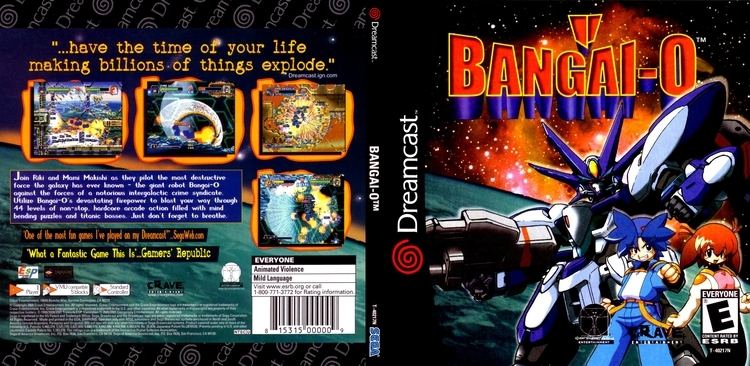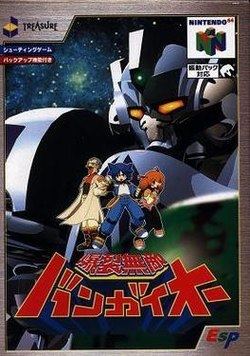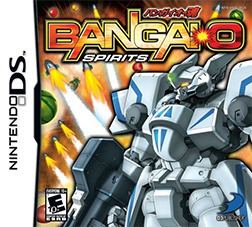9.6 /10 1 Votes9.6
Designer(s) Yoshiyuki Matsumoto Initial release date 3 September 1999 | 4.8/5 Emuparadise Mode(s) Single player Series Bangai-o series Genre Shoot 'em up | |||||||||||||||||||||||||||||||||
Composer(s) Toshiya YamanakaAki HataKazuo Hanzawa Release date(s) Nintendo 64JP: September 3, 1999DreamcastJP: December 9, 1999EU: October 20, 2000NA: March 21, 2001Xbox Live ArcadeINT: May 4, 2011 Similar Treasure games, Shoot 'em up games | ||||||||||||||||||||||||||||||||||
Cgrundertow bangai o hd missile fury for xbox 360 video game review
Bangai-O, or Bakuretsu Muteki Bangaioh (爆裂無敵 バンガイオー, Bakuretsu Muteki Bangaiō, Explosive, Invincible Bangaioh) in the Nintendo 64 and Japanese Dreamcast versions, is a multi-directional shooter video game developed by Treasure. It was first released on the Nintendo 64 with a limited 10,000 unit production run. It was ported to the Dreamcast a few months later, and this version was eventually released worldwide.
Contents
- Cgrundertow bangai o hd missile fury for xbox 360 video game review
- Review rating bangai o dreamcast
- Plot
- Gameplay
- Nintendo 64 version
- Dreamcast version
- Series
- Reception
- References

In 2008, a sequel, Bangai-O Spirits was released for Nintendo DS. A high definition version, Bangai-O HD: Missile Fury, was released for Xbox Live Arcade in May 2011.

Review rating bangai o dreamcast
Plot
The game has a simple storyline (though slightly differing scripts among the Japanese, European, and North American releases) conveyed through intermission screens and dialogue interruptions, with character portraits and captions, triggered by approaching objects in normal play. Two young mecha pilots, Riki and his sister Mami share command of the powerful humanoid-shaped Bangai-O and battle villains from the "Cosmo Gang", guilty of fruit contraband, and lots of gun turrets, bombs and robots through 44 levels.
Gameplay

Bangai-O, the player's mecha, is maneuvered via eight-way directional controls and fires in eight directions, controlled by the controller's four face buttons. Two firing modes are represented as switching between the two pilots (the current one is displayed at all times in a portrait): Riki fires red homing missiles and Mami fires blue lasers that bounce off walls.
There is a special attack that consists of a 360 degree burst of the current shot type. The number of shots fired by the special attack, 40 to 400, depends on how many enemy bullets are on the screen and how close the player is to them while firing. The missile special attack splits between multiple targets; the laser special attack points towards a target after bouncing.
At the beginning of a level two special shots are available; destroying enemies and scenery gives additional uses, up to five available shots, and this recharging effect is shown as a meter.
The number of explosions taking place at any given time is shown at the top of the screen and determines how much the special attack meter recharges and what type of fruit is left behind by destroyed enemies. Higher numbers of explosions yield more special energy and more valuable types of fruit. Therefore, the tactic of inviting substantial enemy fire in order to counter with the special attack is key to success at the game.
Nintendo 64 version
The original version of the game, released only in Japan and limited to 10,000 cartridges, has significant differences to the Dreamcast version.
Dreamcast version
The second version of the game saw release in Japan, Europe, and North America. As a result, it is the version that the title is primarily identified with.
In addition to minor graphical and audio improvements, the gameplay was altered significantly.
The Dreamcast version defaults to the simpler but less flexible "AB" control configuration (one button to shoot in the direction of movement and one to shoot backwards) with the variable "ABXY" configuration (one button to shoot in each direction, with combinations of two buttons for diagonals) as the secondary scheme. The game's documentation notes that the default scheme is inferior, and suggests changing it.
Series
Bangai-O was originally conceived as a remake of an obscure 8-bit shooter, Hover Attack, first published as a type-in game for the Sharp X1 released in 1983. Eventually it evolved into an original property, but retains many elements of the original including the distinctive missile trails and a general aesthetic similarity and could be considered a spiritual sequel.
Instead it was made as an independent game, even though it retains most of the original style.
A sequel, Bangai-O Spirits, developed for the Nintendo DS, was released on March 19, 2008 in Japan and on August 12, 2008 in the USA by D3 Publisher.
A high definition version, Bangai-O HD: Missile Fury, was developed for Xbox Live Arcade, published by D3 Publisher. It features twin analogue stick control, a level editor and co-operative and competitive multiplayer. Initially announced for a release in November 2010, it has been delayed until Spring 2011 to incorporate the multiplayer modes.
Reception
On release, Famitsu magazine scored the Nintendo 64 version of the game a 30 out of 40.
